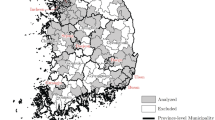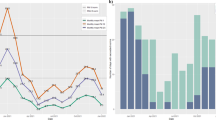Abstract
This paper reports a meta analysis of how effectively hedonic property models have detected the influence of air pollution on housing prices. Probit estimates are reported describing how data, model specification, and local property market conditions in cities represented in thirty-seven studies influence the ability of hedonic models to uncover negative, statistically significant relationships between housing prices and air pollution measures.
Similar content being viewed by others
Appendix A
Anderson, Robert J. Jr. and Thomas D. Crocker (1971), ‘Air Pollution and Residential Property Values’, Urban Studies 8. (6)
Appel, David (1980), ‘Estimating the Benefits of Air Quality Improvement: An Hedonic Price Index Approach Applied to the New York Metropolitan Area’, Rutgers University, PhD Dissertation. (31)
Atkinson, Scott E. and Thomas D. Crocker (1982), ‘A Bayesian Approach to Assessing the Robustness of Hedonic Property Value Studies’. (22)
Bender, Bruce, Timothy J. Gronberg and Hae-Shin Hwang (1979), ‘Choice of Functional Form and the Demand for Air Quality’, The Review of Economics and Statistics. (3)
Bender, Bruce and Hae-Shin Hwang (1985), ‘Hedonic Housing Price Indices and Secondary Employment Centers’, Journal of Urban Economics 17. (25)
Berry, Brian J. L. (1976), ‘Ghetto Expansion and Single-Family Housing Prices: Chicago, 1968–1972’, Journal of Urban Economics 3. (28)
Blomquist, Glenn C., Mark C. Berger and John P. Hoehn (1988 Mar.), ‘New Estimates of Quality of Life in Urban Areas’, American Economic Review. (18)
Bresnock, Anne E. (1981), ‘Housing Prices, Income and Environmental Quality in Denver’, PhD Dissertation. (23)
Brookshire, David S., R. C. d'Arge, W. D. Schulze, and M. A. Thayer (1979), ‘Experiments in Valuing Non-Market Goods: A Case Study of Alternative Benefit Measures of Air Pollution Control in the South Coast Air Basin of Southern California’, Chap. 5, Vol II. (16)
Brookshire, David S., Mark A. Thayer, William D. Schulze and Ralph C. d'Arge (1982), ‘Valuing Public Goods: A Comparison of Survey and Hedonic Approaches’, American Economic Review 72(1). (24)
Brucato, Peter F., Jr., James C. Murdoch and Mark A. Thayer (1990), ‘Urban Air Quality Improvements: A Comparison of Aggregate Health and Welfare Benefits to Hedonic Price Differential’, Journal of Environmental Management 30, 265–279. (37)
Deyak, Timothy A. and V. Kerry Smith (1974), ‘Residential Property Values and Air Pollution: Some New Evidence’, Quarterly Review of Economics and Business 14(4). (9)
Diamond, Douglas B. Jr. (1980), ‘The Relationship Between Amenities and Urban Land Prices’, Land Economics 56(1). (10)
Egan, Francis Joseph (1973), ‘Air Pollution and Property Values in the Hartford Metropolian Region’, Fordham University, PhD Dissertation. (33)
Goodwin, Susan Ann (1977), ‘Measuring the Value of Housing Quality — A Note’, Journal of Regional Science 17(1). (14)
Graves, Phil, James C. Murdoch, Mark A. Thayer and Don Waldman (1988), ‘The Robustness of Hedonic Price Estimation: Urban Air Quality’, Land Economics 64(3). (34)
Harrison, David Jr. and Daniel L. Rubinfeld (1978), ‘Hedonic Housing Prices and the Demand for Clean Air’, Journal of Environmental Economics and Management 5. (1)
Hoehn, John P., Mark C. Berger and Glenn C. Blomquist (1987), ‘A Hedonic Model of Interregional Wages, Rents, and Amenity Values’, Journal of Regional Science 27(4). (35)
Jackson, Jerry R. (1979), ‘Intraurban Variation in the Price of Housing’, Journal of Urban Economics 6. (29)
Krumm, Ronald J. (1980), ‘Neighborhood Amenities: An Economic Analysis’, Journal of Urban Economics 7. (8)
Li, Mingche M. and H. James Brown (1980), ‘Micro-Neighborhood Externalities and Hedonic Housing Prices’, Land Economics 56(2). (11)
Mark, Jonathan H. (1980), ‘A Preference Approach to Measuring the Impact of Environmental Exernalities’, Land Economics 56(1). (12)
McDonald, John F. (1980), ‘The Use of Proxy Variables in Housing Price Analysis’, Journal of Urban Economics 7. (27)
Murdoch, James C. and Mark A. Thayer (1988), ‘Hedonic Price Estimation of Variable Urban Air Quality’, Journal of Environmental Economics and Management 15. (36)
National Academy of Sciences (1974), ‘Air Quality and Automobile Emission Control’, A Report by the Coordinating Committee on Air Quality Studies 4. (19)
Nelson, Jon P. (1978), ‘Residential Choice, Hedonic Prices, and the Demand for Urban Air Quality’, Journal of Urban Economics 5. (5)
Palmquist, Raymond B (1982), ‘Estimating the Demand for Air Quality From Property Value Studies’. (20)
Palmquist, Raymond B. (1983), ‘Estimating the Demand for Air Quality From Property Value Studies: Further Results’. (21)
Palmquist, Raymond B. (1984), ‘Estimating the Demand for the Characteristics of Housing’, Review of Economics and Statistics 66. (15)
Polinsky, A. Mitchell and Daniel L. Rubinfeld, Property Values and the Benefits of Environmental Improvements: Theory and Measurement, Public Economics and the Quality of Life. Edited by Lowdon Wingo and Alan Evans. (13)
Ridker, Ronald G. and John A. Henning (1967 May), ‘The Determinants of Residential Property Values With Special Reference to Air Pollution’, Rev. Econ. St. 49. (2)
Smith, Barton A. (1978), ‘Measuring the Value of Urban Amenities’, Journal of Urban Economics 5. (7)
Smith, V. Kerry and Timothy A. Deyak (1975), ‘Measuring the Impact of Air Pollution on Property Values’, Journal of Regional Science 15(3). (30)
Sonstelie, Jon C. and Paul R. Portney (1980), ‘Gross Rents and Market Values: Testing the Implications of Tiebout's Hypothesis’, Journal of Urban Economics 7. (26)
Soskin, Mark D. (1979), ‘Detection and Treatment of Multicollinearity With Application to Problems of Estimating Pollution Costs from Housing Market Models’, The Pennsylvania State University, PhD Dissertation. (32)
Spore, Robert L (1972 June), ‘Property Value Differentials As a Measure of the Economic Costs of Air Pollution’, Center for Air Environment Studies, The Pennsylvania State University, Publication No. 254-72. (17)
Wieand, Kenneth F. (1973) ‘Air Pollution and Property Values: A Study of the St. Louis Area’, Journal of Regional Science 13(1). (4)
References
Cordray, David S. (1987), ‘Strengthening Causal Interpretations of Non-Experimental Data: The Role of Meta Analysis’, in L. Sechrest, J. Bunker and E. Perrin (eds.), Improving Methods in Non-Experimental Research. Menlo Park, CO: Sage Publications.
Freeman, III, A. Myrick (1974 May), ‘On Estimating Air Pollution Control Benefits From Land Value Studies’, Journal of Environmental Economics and Management 2, 74–84.
Glass, G. V. (1976), ‘Primary, Secondary, and Meta-Analysis of Research’, Educational Researcher 5(1), 3–8.
Graves, Phil, James C. Murdoch, Mark A. Thayer and Don Waldman (1988 Aug), ‘The Robustness of Hedonic Price Estimation: Urban Air Quality’, Land Economics 64, 220–233.
Hedges, L. V. and I. Olkin (1985), Statistical Methods for Meta Analysis. New York: Academic Press.
Hendry, David F. (1983 Nov), ‘Econometric Modeling: The ‘Consumption Function’ in Retrospect’, Scottish Journal of Political Economy 30, 193–220.
Huber, P. J. (1967), ‘The Behavior of Maximum Likelihood Estimates Under Non-Standard Conditions’, Proceedings of the Fifth Symposium on Mathematical Statistics and Probability, University of California Press, 221–233.
McFadden, Daniel (1974), ‘The Measurement of Urban Travel Demand’, Journal of Public Economics 3, 303–328.
Nakamura, A. O., M. Nakamura and H. O. Duleep (1990), ‘Alternative Approaches to Model Choice’, Journal of Economic Behavior and Organization 14, 97–125.
Palmquist, Raymond B. (1982), ‘Estimating the Demand for Air Quality From Property Value Studies’, unpublished paper, Department of Economics, North Carolina State University.
Palmquist, Raymond B. (1983), ‘Estimating the Demand for Air Quality From Property Value Studies: Further Results’, unpublished paper, Department of Economics, North Carolina State University.
Palmquist, Raymond B. (1984), ‘Estimating the Demand for the Characteristics of Housing’, Review of Economics and Statistics 66, 394–404.
Ridker, Ronald G. and John A. Henning (1967 May), ‘The Determinants of Residential Property Values With Special Reference to Air Pollution’, Review of Economics and Statistics 49, 246–257.
Rosen, Sherwin (1974), ‘Hedonic Prices and Implicit Markets’, Journal of Political Economy 82, 34–35.
Shechter, Mordechai (1991 Nov), ‘A Comparative Study of Environmental Amenity Valuations’, Environmental and Resource Economics 1, 129–155.
Shechter, Mordechai and M. Kim (1991 Sept), ‘Valuation of Pollution Abatement Benefits: Direct and Indirect Measurement’, Journal of Urban Economics 30, 133–151.
Smith, V. Kerry and Ju Chin Huang (1993 Feb), ‘Can Hedonic Models Value Air Quality? A Meta-Analysis’, Resource and Environmental Economics Program, North Carolina State University, revised.
Smith, V. Kerry and Yoshiaki Kaoru (1990 May), ‘Signals or Noise? Explaining the Variation in Recreation Benefit Estimates’, American Journal of Agricultural Economics, 419–433.
Smith, V. Kerry and Laura Osborne (1993 Feb), ‘Do Contingent Valuation Estimates Inform Environmental Policy?: Visibility Changes at National Parks’, Resource and Environmental Economics Program, North Carolina State University, paper under revision.
White, H. (1980), ‘A Heteroscedasticity-Consistent Covariance Matrix Estimator and a Direct Test for Heteroscedasticity’, Econometrica 48, 817–830.
Author information
Authors and Affiliations
Additional information
Partial support for this research was provided by the Russell Sage Foundation. Thanks are due David Cordray, Heidi Hartman, and Larry Hedges of the Foundation's Meta-Analysis Panel for constructive comments, to Ray Palmquist for suggestions and assistance in assembling the results from his studies, to Rick Freeman and Tom Tietenberg and two anonymous referees for comments on the research, and to Barbara Scott for constructive editing of earlier drafts of this paper.
Rights and permissions
About this article
Cite this article
Smith, V.K., Huang, J.C. Hedonic models and air pollution: Twenty-five years and counting. Environ Resource Econ 3, 381–394 (1993). https://doi.org/10.1007/BF00418818
Issue Date:
DOI: https://doi.org/10.1007/BF00418818




